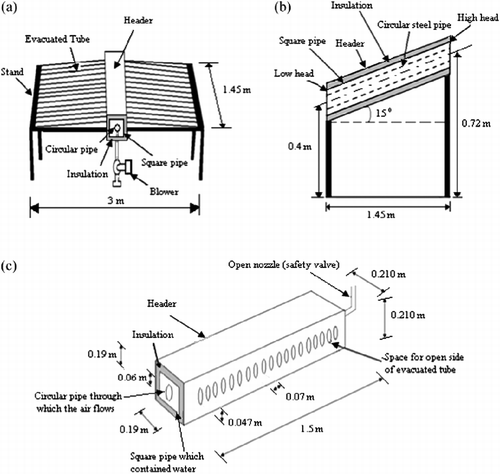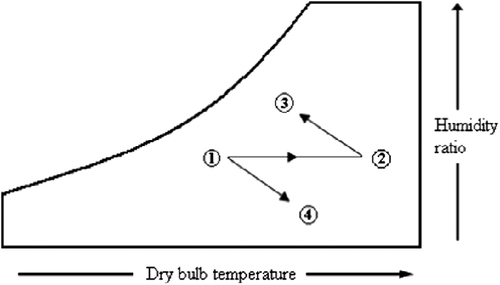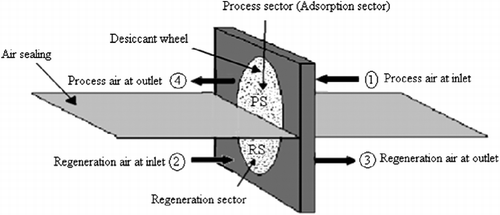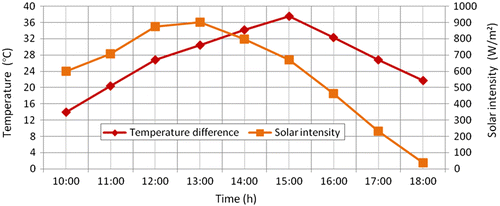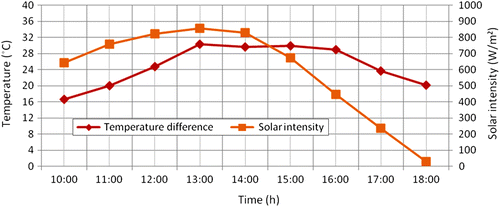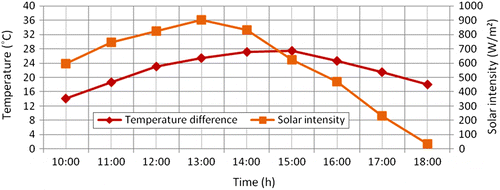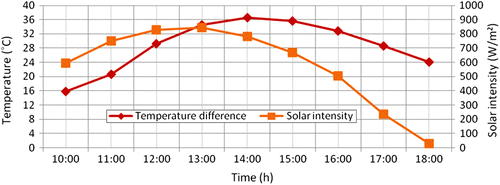Abstract
The regeneration and adsorption of desiccant wheel for producing the dry air was experimentally investigated. The air needed for regeneration was heated in an evacuated tube solar collector with surface area 4.44 m2. The desiccant wheel is regenerated at the temperature in the range of 43.9–72.6°C. The regeneration and adsorption performances are affected by the regeneration temperature, wheel rotation, air flow rate (process and regeneration) and ambient conditions. By comparing the adsorption and regeneration performance at different air flow rate and constant rph, it was found that maximum adsorption and regeneration rates are obtained at air flow rate of 210.789 kg/h. Regeneration temperature directly affects the effectiveness of the desiccant wheel. Maximum desiccant wheel effectiveness of regeneration sector and adsorption sector is obtained at air flow rate of 105.394 kg/h. The regeneration performance of desiccant wheel with evacuated tube solar air collector is suitable for the Indian climate.
Nomenclature
| E A | = |
effectiveness of wheel in process sector |
| E R | = |
effectiveness of wheel in regeneration sector |
| ETC | = |
evacuated tube collector |
| in | = |
inlet |
|
| = |
air flow rate of process air (kg/h) |
|
| = |
air flow rate of regeneration air (kg/h) |
| N | = |
rotational speed (rph) |
| out | = |
outlet |
| G A | = |
adsorption rate (kg/h) |
| G R | = |
regeneration rate (kg/h) |
| Y | = |
humidity ratio of the air (kgwater vapour/kgdry air) |
| θp | = |
angular sector of process air (degree) |
| θr | = |
angular sector of regeneration air (degree) |
Introduction
This paper presents a system designed to produce dry air from the atmospheric air by using solar energy. In the case of conventional system, dry air is produced by cooling the air below the dew point temperature and consumes more electricity which is a form of high grade energy. In the past, Dunkle (Citation1965) presented an alternative method where regeneration of desiccant material was done by solar energy for producing the dry air. Currently, an air conditioner is becoming a basic need in human life and in future, it is expected to play a vital role in our lives. Conventional air conditioning (A/C) is based on vapour compression system (VCS) utilising hydro-fluoro-carbon (HFC) and hydro-chloro-fluoro-carbon (HCFC), which are harmful to the environment. Dai et al. (Citation2001) suggested that a desiccant cooling system is one of the best options to be used for A/C as it deals with the latent load and improves the indoor air quality by adsorbing moisture and by preventing the contamination of air simultaneously. Desiccant dehumidifier running in open cycle, which is characterised by no noise and low maintenance, can be driven by solar energy or waste heat. Sheridan and Mitchell (Citation1985) described a desiccant cooling system which is more attractive alternatives than conventional vapour compression systems due to their advantages of utilising low-temperature energy and of providing an environmental-conscious operation.
Many researchers have worked on regeneration of desiccant wheel by solar heat and waste heat as given; Rush et al. (Citation1975) reported on a test installation, which used both solar energy and natural gas to regenerate the desiccant wheel in Los Angeles and coefficient of performance (COP) was found to be 0.53 at one operating point. Nelson et al. (Citation1978) analysed an open cycle A/C system by using solid desiccant and solar energy. They also developed a computer model of the various components of the desiccant system and evaluated the potential of solar energy system to provide regeneration of dehumidifier under typical weather condition and suggested that the solar energy is a better match for cooling and dehumidification system. Collier et al. (Citation1981) described that the solid desiccants can be regenerated using low-grade thermal energy at temperature levels that depend on which desiccant material was used. For example silica gel is one of the most extensively investigated and promising solid desiccant materials which requires a regeneration temperature of about 65°C. Monnier et al. (Citation1982), Barlow (Citation1983) developed an energy efficient A/C system after combining a vapour compression (VC) unit with the proper solid desiccant dehumidifier. This system relieves the VC unit from the latent heat portion of the load at the expense of the energy required for the desiccant regeneration process. They also suggested that such energy can be supplied in one or more of the following forms viz. solar energy is applied by using flat plate collectors, direct fuel firing or waste heat recovery. Kettleborough (Citation1983) described the basic solar-assisted comfort conditioning systems and stated that at that time VCS was more economical for cooling and dehumidification than other system but suggested that more research and development are required due to limitation of fossil fuels. Jurinak et al. (Citation1984) evaluated the performance of open-cycle desiccant air conditioners for residential application and compared with the VC air conditioner system on the basis of cost and energy. They also suggested that when these systems are coupled with solar energy to regenerate the desiccant wheel, they performed better than the conventional air conditioners. Joudi and Madhi (Citation1987) carried out experimental analysis on solar-assisted desiccant cooling system. Air was heated by using solar air heater for regeneration at temperature 70°C. Performance of the system was enhanced at higher regeneration temperature, higher air mass flow rate and dry weather but system was less efficient than commercial VCS and it also had a large physical size. Banks (Citation1992) tested a gas-fired desiccant dehumidification system having heat pipe and direct expansion cooling and heating system in two different wings of hotel. The performance of desiccant-based dehumidification system and direct expansion cooling system was evaluated. It was found that desiccant-based system is beneficial in terms of low initial cost and operating cost when waste heat is available at 80–90°C. Thorpe (Citation1998) developed and analysed a mathematical model of a solar regenerated open-cycle grain cooling system and the regeneration of desiccant was done by solar energy. It was observed that the grain cooler works effectively in temperate and subtropical climates but not works effectively in humid tropics. Singh and Singh (Citation1998) fabricated and tested a multi-shelf dehumidifier and a packed bed dehumidifier with the effect of regeneration air temperature range of 42–72°C, bed air velocity range of 0.175–0.55 m/s and number of shelves on silica gel. It was found that the regeneration time reduced with an increase in rest period for all values of number of shelves. Techajunta et al. (Citation1999) carried out experimental investigations on the regeneration of silica gel bed with simulated solar energy in which incandescent electric bulbs were used to simulate solar irradiation. The regeneration rate was found to be strongly dependent on the solar radiation intensity whereas its dependence on the air flow rate was found to be weak and he suggested that this system works better in tropical humid climates using regeneration process in day and dehumidification in night. Henning et al. (Citation2001) studied a system in which solar air collector is integrated into the desiccant cooling cycle as the heat source only and compared their performance for different climatic conditions and configurations. This system performed better under high value of ambient humidity and the combination of A/C system with the solar thermal collector and saved the primary energy up to 50%. Mavroudaki et al. (Citation2002) presented a model in which solar desiccant cooling was used to evaluate the potential for using solar energy to drive a single-stage desiccant cooling system with condition of low latent heat gain. They also suggested that this system was less efficient in the higher relative humidity environment because the temperature required for regeneration is too high. Ahmed et al. (Citation2005) fabricated an experimental set-up of a solar desiccant wheel using a numerical method to simulate mass and heat transfer for regeneration and adsorption process and tested under various climate conditions. They also discussed the effect of operating parameters and design parameters on the desiccant wheel performance. Jalalzadeh-Azar et al. (Citation2005) fabricated and tested a cooling system in a combined heat and power (CHP) application incorporating a reciprocating internal combustion engine, heat exchanger, desiccant dehumidifier and direct/indirect dehumidifier. The regeneration of desiccant wheel occurred by using the heat recovered from internal combustion engine. The COP of this system was found to be five which is higher in comparison to conventional system. Kodama et al. (Citation2005) experimentally tested a solar desiccant cooling system and investigated its actual performance with configuration of the desiccant wheel, sensible heat exchanger and two water evaporative cooler driven with solar heated water. The performance was studied at various operating conditions such as regeneration temperature, air condition of ambient air and solar irradiation. It was found that stable solar irradiation (600 W/m2) and high regeneration temperature (50°C) was required to produce sufficient cool air. Zhuo et al. (Citation2006) designed and manufactured a desiccant A/C system. The desiccant wheel was made of composite silica gel and regenerated by solar air heater by keeping the indoor air temperature in the range of 24–28°C and relative humidity in the range of 50–70%. It also showed that the feasibility to use low-grade energy (solar energy) in A/C system using a desiccant wheel. Kabeel (Citation2007) studied a solar-assisted desiccant wheel made up of iron wire and cloth layer impregnated with CaCl. In this system, a solar air heater containing a porous material was used for regeneration purpose and the effect of air flow rate and solar radiation intensity on the system for regeneration and absorption process was analysed. It was found to be very effective in regeneration process as compared to silica gel. Maximum efficiency (i.e. 0.6) was found at wheel effectiveness 0.92 for regeneration process and 0.65 for absorption process at a flow rate of 90 kg/h. Pramuang and Exell (Citation2007) used a compound parabolic concentrator collector to regenerate the silica gel for an A/C system. The regeneration rate and regeneration efficiency were greatly dependant on solar radiation but slightly dependant on different initial moisture contents on silica gel and a number of silica gel beds. Silica gel could regenerate at 40°C by high air flow rate (0.03 kg/s) and regenerate at 50°C by low flow rate (0.003 kg/s). Bourdoukan et al. (Citation2008) used a heat pipe vacuum tube (HPVT) collector in solar desiccant cooling system to overcome the problem of flat plate collector. The efficiency of HPVT collector was between 0.6 and 0.7 for one operating day. The same efficiency was obtained by flat plate collector but area has to be increased by 20–25%. Hence, HPVT is a better option for regeneration of desiccant wheel. Ge et al. (Citation2010) compared a solar-driven two-stage rotary desiccant cooling system with a VCS and evaluated its performance in terms of thermodynamic and economic data for two different cities namely Berlin and Shanghai. It was found that desiccant cooling system has advantages of higher fresh air ratio and less electricity consumption than vapour compression refrigeration (VCR). Also the required regeneration temperatures were 55 and 85°C for Berlin and Shanghai, respectively. Ge et al. (Citation2012) developed and simulated a solar power desiccant-coated heat exchanger model and evaluated its performance under Shanghai summer condition with high temperature as well as high humidity ratio. It was found that this system supplied sufficient air to be conditioned for indoor space in the month of June and July during the daytime and its cooling powers were 2.9 and 3.5 kW and its corresponding COP were 0.22 and 0.24, respectively. They also calculated and discussed the effect of main design parameter of system performance. Yadav and Bajpai (Citation2011a) experimentally investigated on a solar-powered air heating system using one-ended evacuated tubes and found that the maximum temperature difference 36.8°C is obtained by the evacuated tube solar air collector at an air flow rate of 0.0268 kg/s in summer, India. Yadav and Bajpai (Citation2011b) experimentally investigated that desiccant performed well in adsorption process and desiccants have been regenerated at the temperature in the range of 54.3–68.3°C by using an evacuated tube solar air collector at different flow rates in India.
Many researchers experimentally and numerically investigated the use of solar energy to regenerate the desiccant wheel by using flat plate and HPVT and compound parabolic concentrator collector but none focused on to check the potential of solar energy in Indian climate by using normal evacuated tube to regenerate the desiccant wheel. This paper investigates the adsorption performance of the desiccant wheel at different air flow rates and the desiccant wheel is regenerated by evacuated tube solar air collector. The experiments were carried out at NIT Kurukshetra, India [29° 58′ (latitude) North and 76° 53′ (longitude) East].
Experimental set-up
In this set-up, desiccant wheel is integrated with evacuated tube solar air collector and two blowers. Evacuated tube solar air collector produces the hot air for regeneration of the desiccant wheel. In this set-up, regeneration and adsorption occurs simultaneously during the day (Figure ).
Figure 1 (a) Schematic diagram of an experimental set-up. (b) Photograph of the experimental set-up.
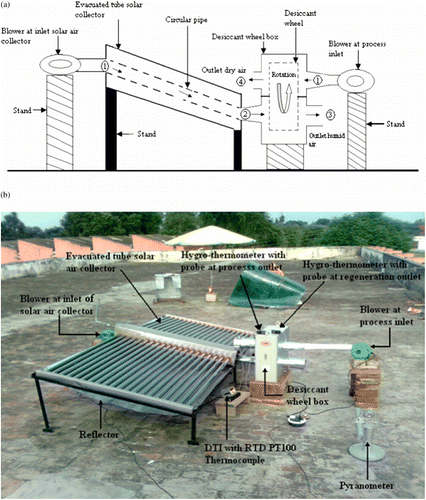
The system consists of the following two parts:
(i) Evacuated tube solar air collector | |||||
(ii) Desiccant wheel | |||||
Evacuated tube solar air collector
A normal evacuated tube solar air collector as shown in Figure (a),(b) is used for regeneration of desiccant wheel. The collector surface area is 4.44 m2. The evacuated tube consists of an outer glass tube (transparent tube) and an absorber tube (coated with Al–N/Al). The length, outer diameter of the outer glass tube and absorber tube are 1.5, 0.047 and 0.037 m, respectively. This evacuated tube solar air collector consists of a header (heat exchanger) of square shape (0.19 × 0.19 m) as shown in Figure (c). The length of header is 1.5 m. A circular pipe (hollow pipe made of stainless steel) of diameter 0.060 m is placed at the centre of the header. The air flows through the circular pipe. The evacuated tube solar air collector contains approximately 108 l of working fluid (mixture of water, 80% and ethylene glycol, 20%). The working fluid works as a heat-collecting medium which collects the solar radiations incident on the tubes. This heat is transferred to the air which flows through the circular pipe.
A blower with power of 0.335 kW is used to blow the air in the evacuated tube solar air collector. The blower is powered by mains AC supply and the air flow rate is controlled by using a controlling unit.
Desiccant wheel
A desiccant wheel is an air to air heat and mass exchanger with a relatively low rotational speed (N). It consists of number of flow channels, each having a thin layer of desiccant and matrix material (supporting materials). The channels in the desiccant wheel can be of various shapes such as sinusoidal, honeycomb, triangular, etc. In this model, the shape of channel is sinusoidal. The desiccant wheel is divided into two sectors according to the air stream passed. In the angular sector of process air (adsorption sector), dehumidification of air takes place, and in the angular sector of regeneration air [regeneration sector (RS)] of the wheel, humidification of the air takes place. The sector angle of process air and regeneration air denoted by ‘θp’ and ‘θr’, respectively. The rotation of the wheel causes periodic regeneration of the adsorption sector (Figure ).
Figure 3 (a) Schematic diagrams of rotary desiccant wheel. (b) Photograph of the desiccant wheel. (c) Photograph of the driving system. (d) Schematic diagram of the desiccant wheel box.
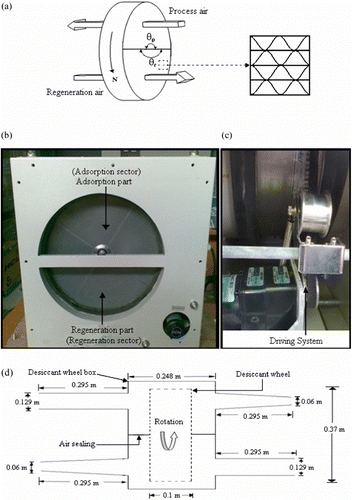
The rotary desiccant wheel is made of desiccant material (silica gel) of 0.370 m diameter and 0.1 m length. It is divided into two parts. The first part is the adsorption sector that equals 50% of the total surface area. The second part is the RS that equals 50% of the total surface area. The two parts are separated carefully. The pitch and height of the flow passage of one channel are 0.0032 and 0.0018 m, respectively, and thickness of channel is 0.00034 m. Rotary motor with power of 6 W is used to drive the desiccant wheel at different rph to alternate the position of the adsorption sector and RS (Table ).
Table 1 Specifications of the desiccant wheel.
Measuring devices and instruments
Temperature was measured with a RTD PT100 thermocouple connected to a digital temperature indicator that shows the temperature with a resolution of 0.1°C.
Relative humidity and temperature of air were measured with a digital hand-held Hygro-thermometer model RHT–200C (Elinco Innovations, Ambala, India) with high accuracy probe which has a relative humidity range from 0% to 100% and a temperature range from − 10 to 60°C. The humidity multimeter measures the relative humidity with a resolution 0.1% and accuracy ± 2%, and the temperature with a resolution of 0.1°C and accuracy ± 0.3°C.
The moisture ratio of the processed air has been calculated from the dry bulb temperature and relative humidity by using a Psychrometric calculator.
The air velocity was measured at the beginning of experimental work. A separate probe anemometer model AM-4201 (Lutron Electronic Enterprise CO. Ltd, Taipei, Taiwan) was used to measure the velocity of air with an accuracy ± (2%+1d) and resolution 0.1 m/s.
The solar radiation intensity was measured during the regeneration process using a Pyranometer model CM11 (Kipp and Zonen, Delft, Holland).
System operation
The three processes taking place in the system as shown in Figure are:
| a. | Sensible heating (1 and 2): sensible heating of air is done by using evacuated tube solar air collector.
| ||||
| b. | Regeneration process (2 and 3): hot air is used to regenerate the desiccant wheel in the RS. The hot air evaporates the water vapour from desiccant layer; hence, in this process the hot air loses its temperature. | ||||
| c. | Adsorption process (1–4): humid air flows through the adsorption sector. The adsorption sector adsorbs the moisture from the humid air. This moisture is adsorbed on the surface of desiccant and is condensed over it. The heat released from the condensation process raises the temperature of the process air. | ||||
When process air flows through the desiccant surface in adsorption sector, its vapour pressure is more than that at desiccant surface due to high humid air condition which creates high vapour pressure difference. Hence, adsorption occurs.
In the RS, point ‘2’ indicates regeneration air at inlet from evacuated tube solar air collector and point ‘3’ indicates humidified air through RS of the desiccant wheel.
When regeneration air flows through the desiccant surface in RS, it heats the desiccant surface and raises its vapour pressure which results in an increase in the vapour pressure difference between the desiccant surface and regeneration air. Hence, regeneration occurs.
Analysis of experimental data
The rate of the moisture extracted from air by the adsorption is given by
Experimental results and discussion
The experimental data were recorded at an interval of 1 h during the day time (10:00–18:00 h) from 22 September to 25 September 2011.
When the experiments were carried out, the ambient temperature was in the range of 30–34°C on most of the days, but sometimes it reached up to maximum of 35°C also. The moisture lied in the range of 0.015–0.019 kgwater vapour/ kgdry air. In this experiment, wheel speed was kept constant at 22 rph.
Case 1: solar-powered desiccant wheel performance at an air flow rate of 105.394 kg/h in both sectors (regeneration and adsorption)
The performance of solar-powered desiccant dehumidifier depends upon the evacuated tube solar air collector and the desiccant wheel. Performance of solar-powered desiccant wheel is analysed in the form of adsorption rate, regeneration rate and wheel effectiveness of both the sector under various operating, structural and ambient conditions (shown in Tables and ).
Table 2 Operating and structural parameters.
Table 3 Recorded data of ambient conditions and regeneration temperature on 22 September 2011.
Performance of evacuated tube solar air collector at an air flow rate of 105.394 kg/h
Figure shows that initially the temperature difference of air in evacuated tube solar air collector increases with an increase in solar intensity and then decreases with a decrease in solar intensity after some time lag. The maximum value of solar intensity is 901 W/m2 obtained at 13:00 h but the maximum value of temperature difference of air in evacuated tube solar air collector is 37.5°C obtained at 15:00 h at an air flow rate of 105.394 kg/h due to high heat capacity of working fluid in the evacuated tube solar air collector. In the morning when solar intensity increases, working fluid starts absorbing more heat than releasing it to air till its maximum value is achieved but after solar noon onwards when the solar intensity starts decreasing, working fluid releases more heat to air (stored heat) than its absorbing capacity.
Regeneration rate of desiccant wheel
Figure shows that initially regeneration rate increases with an increase in the regeneration temperature and then decreases with a decrease in the regeneration temperature. The maximum regeneration rate is 0.552 kg/h at 13:00 h and at the regeneration temperature of 65°C. The minimum regeneration rate is 0.125 kg/h at 17:00 h and at the regeneration temperature 60°C. The results showed that the average regeneration rate is 0.261 kg/h at an average regeneration temperature of 49.16°C during the day.
Figure 7 Variation of regeneration rate and regeneration temperature during the day with an air flow rate of 105.394 kg/h.
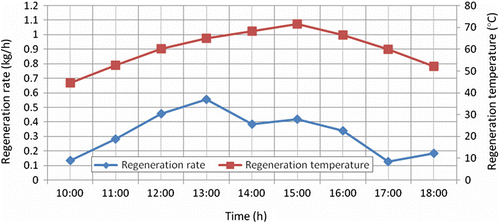
Regeneration rate also depends upon ambient moisture, air flow rate in both the sectors (adsorption and regeneration) and adsorption rate.
Wheel effectiveness in RS
Figure shows that initially wheel effectiveness in RS increases with an increase in the regeneration temperature and decreases with a decrease in the regeneration temperature. The maximum wheel effectiveness on RS is found to be 0.325 at 13:00 h and at the regeneration temperature of 65.0°C. The minimum effectiveness is found to be 0.064 at 17:00 h and at the regeneration temperature of 60.0°C. The results showed the average wheel effectiveness in RS to be 0.144 at an average regeneration temperature of 49.16°C during the day.
Figure 8 Variation of wheel effectiveness in RS during the day with an air flow rate of 105.394 kg/h.
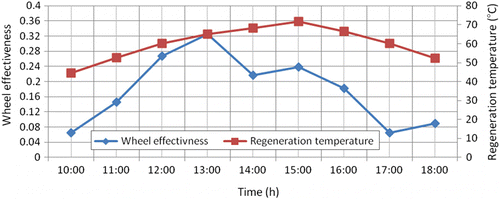
Wheel effectiveness in RS also depends upon air flow rate in both the sectors (adsorption and regeneration) and adsorption rate.
Adsorption rate of desiccant wheel
Figure shows that regeneration temperature directly affects the adsorption rate. Adsorption rate increases with an increase in the regeneration temperature and decreases with a decrease in the regeneration temperature. It is also observed that the maximum adsorption rate is 0.628 kg/h at 16:00 h and at the regeneration temperature of 66.6°C. The minimum adsorption rate is 0.101 kg/h at 10:00 h and at the regeneration temperature of 44.5°C. The results showed the average value of adsorption rate to be 0.318 kg/h at an average regeneration temperature of 49.16°C during the day.
Figure 9 Variation of adsorption rate and regeneration temperature during the day with an air flow rate of 105.394 kg/h.
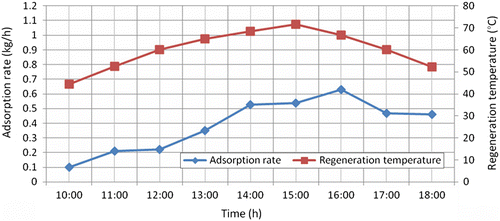
Adsorption rate also depends upon ambient moisture, ambient temperature, air flow rate in both the sectors (adsorption and regeneration) and regeneration rate.
Wheel effectiveness in adsorption sector
Figure shows that initially wheel effectiveness in adsorption sector increases with an increase in the regeneration temperature and decreases with a decrease in the regeneration temperature. The maximum wheel effectiveness of adsorption sector is found to be 0.339 at 16:00 h and at the regeneration temperature of 66.6°C. The minimum effectiveness is found to be 0.050 at 10:00 h and at the regeneration temperature of 44.5°C. The results showed the average value of effectiveness in adsorption sector to be 0.173 at an average regeneration temperature of 49.16°C during the day.
Figure 10 Variation of wheel effectiveness in adsorption sector during the day with an air flow rate of 105.394 kg/h.
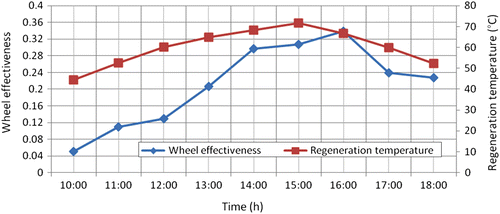
Wheel effectiveness in adsorption sector also depends upon air flow rate in both the sectors (adsorption and regeneration) and regeneration rate.
Case 2: solar-powered desiccant wheel performance at an air flow rate of 210.789 kg/h in both sectors (regeneration and adsorption)
Solar-powered desiccant wheel was analysed under various operating and structural parameters (as shown in Table ) and at ambient conditions during the day (as shown in Table ).
Table 4 Recorded data of ambient conditions and regeneration temperature on 24 September 2011.
Performance of evacuated tube solar air collector at an air flow rate of 210.789 kg/h
Figure shows that initially the temperature difference of air in evacuated tube solar air collector increases with an increase in solar intensity and then decreases with a decrease in solar intensity. The maximum value of solar intensity obtained is 855 W/m2 at 13:00 h and the maximum value of temperature difference obtained is 30.3°C at 13:00 h at an air flow rate of 210.789 kg/h. Also when the solar intensity starts decreasing, temperature difference of air becomes steady for some period and then starts decreasing. This happens due to high air flow rate in the circular pipe which overcomes the effect of heat capacity of working fluid as discussed in Figure .
Regeneration rate of desiccant wheel
Figure shows that initially the regeneration rate increases with an increase in the regeneration temperature and then decreases with a decrease in the regeneration temperature. The maximum regeneration rate is 1.035 kg/h at 14:00 h and at the regeneration temperature of 63.8°C. The minimum regeneration rate is 0.478 at 18:00 h and at the regeneration temperature 50.2°C. The results showed that the average regeneration rate is 0.662 kg/h at an average regeneration temperature of 47.05°C during the day.
Figure 12 Variation of regeneration rate and regeneration temperature during the day with an air flow rate of 210.789 kg/h.
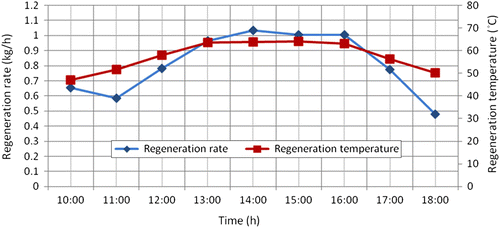
Regeneration rate is higher due to high air flow rate in both the sectors (adsorption and regeneration), even the regeneration temperature is low unlike in the previous case in which air flow rate was low.
Wheel effectiveness in RS
Figure shows that initially wheel effectiveness in RS increases with an increase in the regeneration temperature and decreases with a decrease in the regeneration temperature. The maximum wheel effectiveness on RS is found to be 0.309 at 14:00 h and at the regeneration temperature of 63.8°C. The minimum effectiveness is found to be 0.122 at 18:00 h and at the regeneration temperature of 50.2°C. The results showed the average wheel effectiveness in RS to be 0.186 at an average regeneration temperature of 47.05°C during the day.
Figure 13 Variation of wheel effectiveness in RS during the day with an air flow rate of 210.789 kg/h.
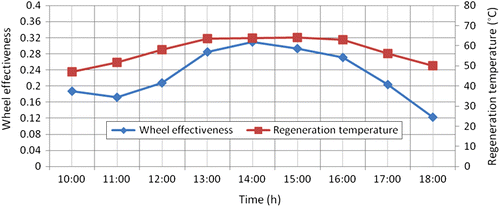
The effectiveness obtained in this case (high air flow rate) is lower than the previous case (low air flow rate) due to low regeneration temperature and high air flow rate which minimises the contact time between desiccant surface and regeneration air.
Adsorption rate of desiccant wheel
Figure shows that regeneration temperature directly affects the adsorption rate. Adsorption rate increases with an increase in the regeneration temperature and then decreases with a decrease in the regeneration temperature. It is also observed that the maximum adsorption rate is 1.146 kg/h at 16:00 h and at the regeneration temperature of 63.0°C. The minimum adsorption rate is 0.262 kg/h at 10:00 h and at the regeneration temperature of 47.1°C. The results showed the average value of adsorption rate to be 0.647 kg/h at an average regeneration temperature of 47.05°C during the day.
Figure 14 Variation of adsorption rate and regeneration temperature during the day with an air flow rate of 210.789 kg/h.
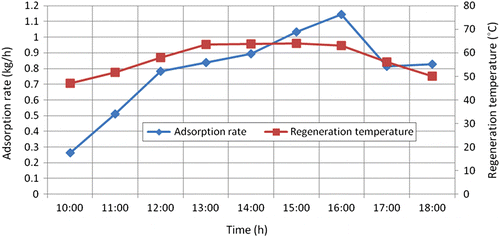
In this case, the value of adsorption rate is higher due to high value of air flow rate; even the regeneration temperature is low unlike in the previous case, in which air flow rate was low.
Wheel effectiveness in adsorption sector
Figure shows that initially wheel effectiveness in adsorption sector increases with an increase in the regeneration temperature and decreases with a decrease in the regeneration temperature. The maximum wheel effectiveness of adsorption sector is found to be 0.309 at 16:00 h and at the regeneration temperature of 63.0°C. The minimum effectiveness is found to be 0.075 at 10:00 h and at the regeneration temperature of 47.1°C. The results showed the average value of effectiveness in adsorption sector to be 0.180 at an average regeneration temperature of 47.05°C during the day.
Figure 15 Variation of wheel effectiveness in adsorption sector during the day with an air flow rate of 210.789 kg/h.
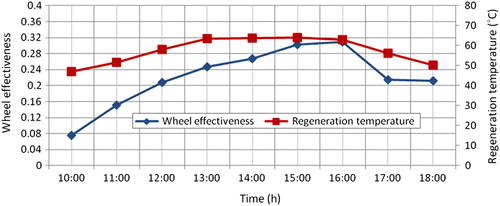
The effectiveness obtained in this case (high air flow rate) is lower than the previous case (low air flow rate) due to low regeneration temperature and high air flow rate which minimises the contact time between desiccant surface and process air.
Case 3: solar-powered desiccant wheel performance at an air flow rate of 210.789 kg/h in RS and at an air flow rate of 105.394 kg/h in adsorption sector
Solar-powered desiccant wheel was analysed under various operating and structural parameters (as shown in Table ) and at ambient conditions during the day (as shown in Table )
Table 5 Recorded data of ambient conditions and regeneration temperature on 23 September 2011.
Performance of evacuated tube solar air collector at an air flow rate of 210.789 kg/h
Figure shows that initially the temperature difference of air in evacuated tube solar air collector increases with an increase in solar intensity and then decreases with a decrease in solar intensity. The maximum value of solar intensity obtained is 902 W/m2 at 13:00 h but the maximum value of temperature difference obtained is 27.4°C at 15:00 h and at an air flow rate of 210.789 kg/h due to the presence of high intensity of solar radiations which enhance the heat capacity (stored energy) of working fluid.
Regeneration rate of desiccant wheel
Figure shows that initially the regeneration rate increases with an increase in the regeneration temperature and then decreases with a decrease in the regeneration temperature. The maximum regeneration rate is 0.613 kg/h at 12:00 h and at the regeneration temperature of 56.2°C. The minimum regeneration rate is 0.073 at 17:00 h and at the regeneration temperature 54.4°C. The results showed that the average regeneration rate is 0.271 kg/h at an average regeneration temperature of 44.75°C during the day.
Figure 17 Variation of regeneration rate and regeneration temperature during the day with an air flow rate of 210.789 kg/h.
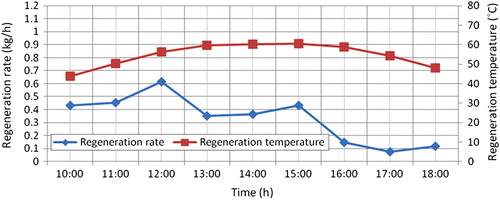
The obtained value of average regeneration rate (0.271 kg/h) is less than that of case 2 where the air flow rate in both the sectors (adsorption and regeneration) is high, but greater than that of case 1 where the air flow rate is low in both the sectors. This happens due to a high air flow rate in the RS and low air flow rate in the adsorption sector.
Wheel effectiveness in RS
Figure shows that initially wheel effectiveness in RS increases with an increase in the regeneration temperature and decreases with an decrease in the regeneration temperature. The maximum wheel effectiveness on RS is found to be 0.161 at 12:00 h and at the regeneration temperature of 56.2°C. The minimum effectiveness is found to be 0.018 at 17:00 h and at the regeneration temperature of 54.4°C. The results showed the average wheel effectiveness in RS to be 0.072 at an average regeneration temperature of 44.75°C during the day.
Figure 18 Variation of wheel effectiveness in RS during the day with an air flow rate of 210.789 kg/h.

The effectiveness obtained in this case is lower than both the above-mentioned cases due to high regeneration air flow rate which minimises the contact time between desiccant surface and regeneration air.
Adsorption rate of desiccant wheel
Figure shows that regeneration temperature directly affects the adsorption rate. Adsorption rate increases with an increase in the regeneration temperature and decreases with a decrease in the regeneration temperature. It is also observed that the maximum adsorption rate is 0.562 kg/h at 13:00 h and at the regeneration temperature of 59.8°C. The minimum adsorption rate is 0.144 kg/h at 10:00 h and at the regeneration temperature of 43.9°C. The results showed the average value of adsorption rate to be 0.321 kg/h at an average regeneration temperature of 44.75°C during the day.
Figure 19 Variation of adsorption rate and regeneration temperature during the day with adsorption air flow rate of 105.394 kg/h.
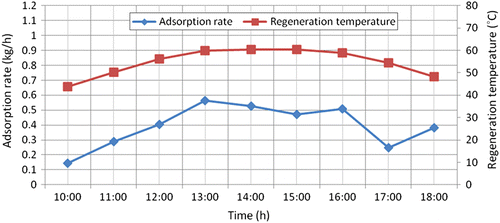
The obtained value of average adsorption rate (0.321 kg/h) is less than that of case 2 where the air flow rate in both the sectors (adsorption and regeneration) is high, but greater than that of case1 where the air flow rate is low in both the sectors. This happens due to a high air flow rate in the RS and low air flow rate in the adsorption sector.
Wheel effectiveness in adsorption sector
Figure shows that initially wheel effectiveness in adsorption sector increases with an increase in the regeneration temperature and decreases with a decrease in the regeneration temperature. The maximum wheel effectiveness of adsorption sector is found to be 0.298 at 13:00 h and at the regeneration temperature of 59.8°C. The minimum effectiveness is found to be 0.078 at 10:00 h and at the regeneration temperature of 43.9°C. The results showed the average value of effectiveness in adsorption sector to be 0.1715 at an average regeneration temperature of 44.75°C during the day.
Figure 20 Variation of wheel effectiveness in adsorption sector during the day with an air flow rate of 105.394 kg/h.
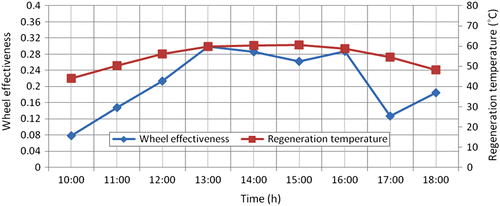
The effectiveness obtained in this case is lower than both the above-mentioned cases due to low regeneration temperature and high air flow rate which minimises the contact time between desiccant surface and process air.
Case 4: solar-powered desiccant wheel performance at an air flow rate of 105.394 kg/h in RS and at an air flow rate of 210.789 kg/h in adsorption sector
Solar-powered desiccant wheel was analysed under various operating and structural parameters (as shown in Table ) and at ambient conditions during the day (as shown in Table ).
Table 6 Recorded data of ambient conditions and regeneration temperature on 25 September 2011.
Performance of evacuated tube solar air collector at an air flow rate of 105.394 kg/h
Figure shows that initially the temperature difference of air in evacuated tube solar air collector increases with an increase in solar intensity and then decreases with a decrease in solar intensity. The maximum value of solar intensity obtained is 844 W/m2 at 13:00 h but the maximum value of temperature difference obtained is 36.6°C at 14:00 h and at an air flow rate of 105.394 kg/h as a result of heat capacity of working fluid. In the morning when solar intensity increases, working fluid starts absorbing more heat than releasing it to the air till its maximum value but afternoon onwards when the solar intensity starts decreasing, working fluid releases more heat to air (stored heat) than its absorbing capacity.
Regeneration rate of desiccant wheel
Figure shows that initially the regeneration rate increases with an increase in the regeneration temperature and then decreases with a decrease in the regeneration temperature. The maximum regeneration rate is 0.646 kg/h at 13:00 h and at the regeneration temperature of 69.6°C. The minimum regeneration rate is 0.123 kg/h at 10:00 h and at the regeneration temperature of 46.3°C. The results showed that the average regeneration rate is 0.336 kg/h at an average regeneration temperature of 50.58°C during the day.
Figure 22 Variation of regeneration rate and regeneration temperature during the day with an air flow rate of 105.394 kg/h.
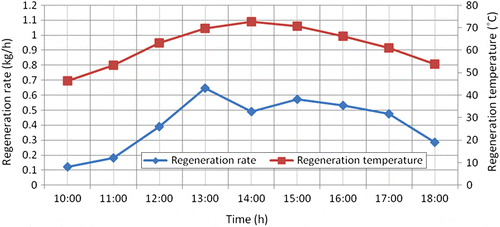
The obtained value of average regeneration rate (0.336 kg/h) is less than that of case 2 where the air flow rate in both the sectors (adsorption and regeneration) is high, but greater than that of case 1 where the air flow rate is low in both the sectors. By comparing cases 3 and 4, it can be concluded that the regeneration rate is higher than case 3 due to high air flow rate in absorption sector. Hence, to increase the performance, increasing the air flow rate in adsorption sector is preferred over RS.
Wheel effectiveness in RS
Figure shows that initially wheel effectiveness in RS increases with an increase in the regeneration temperature and decreases with an decrease in the regeneration temperature. The maximum wheel effectiveness on RS is found to be 0.382 at 13:00 h and at the regeneration temperature of 69.6°C. The minimum effectiveness is found to be 0.074 at 10:00 h and at the regeneration temperature of 46.3°C. The results showed the average wheel effectiveness in RS to be 0.198 at an average regeneration temperature of 50.58°C during the day.
Figure 23 Variation of wheel effectiveness in RS during the day with an air flow rate of 105.394 kg/h.
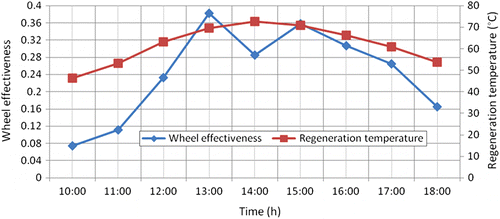
The effectiveness obtained in this case is higher than all the above cases due to low regeneration air flow rate and high regeneration temperature which increases the contact time between desiccant surface and regeneration air.
Adsorption rate of desiccant wheel
Figure shows that regeneration temperature directly affects the adsorption rate. Adsorption rate increases with an increase in the regeneration temperature and decreases with an decrease in the regeneration temperature. It is also observed that the maximum adsorption rate is 0.664 kg/h at 13:00 h and at the regeneration temperature of 69.6°C. The minimum adsorption rate is 0.090 kg/h at 11:00 h and at the regeneration temperature of 53.3°C. The results showed the average value of adsorption rate to be 0.332 kg/h at an average regeneration temperature of 50.58°C during the day.
Figure 24 Variation of adsorption rate and regeneration temperature during the day with process air flow rate of 210.789 kg/h and regeneration air flow rate at 105.394 kg/h.
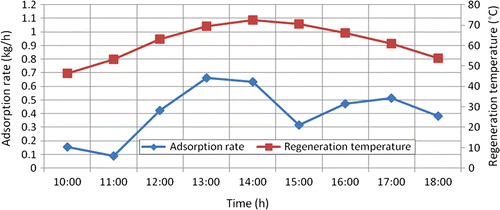
The obtained value of average adsorption rate (0.332 kg/h) is less than that of case 2 where the air flow rate in both the sectors (adsorption and regeneration) is high, but greater than that of case 1 where air flow rate is low in both the sectors. By comparing case 3 and case 4, it can be concluded that the adsorption rate is higher than case 3 due to high air flow rate in absorption sector. Hence to increase the performance, increasing the air flow rate in adsorption sector is preferred over RS.
Wheel effectiveness in adsorption sector
Figure shows that initially wheel effectiveness in adsorption sector increases with an increase in the regeneration temperature and decreases with a decrease in the regeneration temperature. The maximum wheel effectiveness of adsorption sector is found to be 0.196 at 13:00 h and at the regeneration temperature of 69.6°C. The minimum effectiveness is found to be 0.027 at 11:00 h and at the regeneration temperature of 53.3°C. The results showed the average value of effectiveness in adsorption sector to be 0.0974 at an average regeneration temperature of 50.58°C during the day.
Figure 25 Variation of wheel effectiveness in adsorption sector during the day with an air flow rate of 210.789 kg/h.
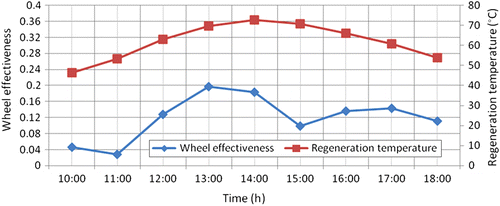
The effectiveness obtained in this case is lower than all the above cases due to high adsorption air flow rate and high regeneration temperature which minimises the contact time between desiccant surface and adsorption air.
Conclusions
Temperature difference of air in evacuated tube solar air collector depends upon solar intensity and air flow rates. Its value increases as air flow rate decreases.
Regeneration temperature is directly proportional to both the adsorption rate and the regeneration rate. Higher regeneration temperature provides higher adsorption and regeneration rate.
Air flow rate is also an important operating parameter which affects the adsorption and regeneration rate of desiccant wheel. As air flow rate increases, both the adsorption rate and the regeneration rate increase and vice versa. As the air flow rate doubles, the adsorption and regeneration rate also become almost double. It is also concluded that the increase in air flow rate in adsorption sector is more effective than increase in air flow rate in RS for the higher performance of desiccant wheel.
To increase the effectiveness of wheel in both the sectors (adsorption and regeneration), regeneration temperature should be high and air flow rate should be low in both the sectors.
Acknowledgments
The evacuated tube solar air collector in this project was provided by Mr H.S. Chadha (M.D), Sunson Energy Devices (P) LTD, New Delhi, India. The authors acknowledge the support from Mr Deepak Pahwa (Chairman), Desiccant rotors international (DRI) India.
References
- Ahmed , M.H. , Fouad , M. and Kattab , N.M. 2005 . Evaluation and optimization of solar desiccant wheel performance . Renewable Energy , 30 : 305 – 325 .
- Banks , N.J. 1992 . Field test of a desiccant-based HVAC system for hotels . ASHRAE Transactions , 98 ( I ) : 1303 – 1310 . AN-92-18-4
- Barlow , R. 1983 . An assessment of dehumidifier geometries for desiccant cooling systems , Golden, CO, USA : Solar Energy Research Institute . SERI/TR-252-1529
- Bourdoukan , P. 2008 . Potential of solar heat pipe vaccum collectors in the desiccant cooling process: modelling and experimental results . Solar Energy , 82 : 1209 – 1219 .
- Collier , R. , Arnold , F. and Barlow , R. 1981 . An overview of open cycle desiccant cooling systems and materials , Golden, CO, USA : Solar Energy Research Institute . SERI/TP-631-1065
- Dai , Y.J. , Wang , R.Z. and Zhang , H.F. 2001 . Parameter analysis to improve rotary desiccant dehumidification using a mathematical model . International Journal of Thermal Science , 40 : 400 – 408 .
- Dunkle , R.V. 1965 . A method of solar air conditioning . Mechanical and Chemical Engineering Transactions , 1 : 73 – 78 .
- Ge , T.S. 2010 . Performance comparison between a solar driven rotary desiccant cooling system and conventional vapour compression system (performance study of desiccant cooling) . Applied Thermal Engineering , 30 : 724 – 731 .
- Ge , T.S. 2012 . Simulation investigation on solar powered desiccant coated heat exchanger cooling system . Applied Energy , 93 : 532 – 540 .
- Henning , H.M. 2001 . The potential of solar energy use in desiccant cooling cycles . International Journal of Refrigeration , 24 : 220 – 229 .
- Jalalzadeh-Azar , A.A. 2005 . Performance assessment of a desiccant cooling system in a CHP application incorporating an IC engine . International Journal of Distributed Energy Resources , 1 ( 2 ) : 163 – 184 .
- Joudi , K.A. and Madhi , S.M. 1987 . An experimental investigation into a solar assisted desiccant-evaporative air-conditioning system . Solar Energy , 39 ( 2 ) : 97 – 107 .
- Jurinak , J.J. , Mitchell , J.W. and Beckman , W.A. 1984 . Open cycle desiccant air conditioning as an alternative to vapour compression cooling in residential applications . Journal of Solar Energy Engineering , 106 : 252 – 260 .
- Kabeel , A.E. 2007 . Solar powered air conditioning system using rotary honeycomb desiccant wheel . Renewable Energy , 32 : 1842 – 1857 .
- Kettleborough , C.F. 1983 . Solar assisted comfort conditioning . Mechanical Engineering , 105 : 48 – 55 .
- Kodama , A. 2005 . An energy flow analysis of a solar desiccant cooling equipped with a honeycomb adsorber . Adsorbtion , 11 : 597 – 602 . Springer Science + Business Media, Inc. Manufactured in Netherlands
- Mavroudaki , P. 2002 . The potential for solar powered single-stage desiccant cooling in southern Europe . Applied Thermal Engineering , 22 : 1129 – 1140 .
- Monnier , J. 1982 . Performance of a cross cooled solar powered desiccant cooling system , Chicago, IL : Illinois Institute Technology . Report No. DES-81-1
- Nelson , J.S. 1978 . Simulations of the performance of open cycle desiccant systems using solar energy . Solar Energy , 21 : 273 – 278 .
- Pramuang , S. and Exell , R.H.B. 2007 . The regeneration of silica gel desiccant by air from a solar heater with a compound parabolic concentrator . Renewable Energy , 32 : 173 – 182 .
- Rush , W. 1975 . “ A description of the solar-MEC field test installation ” . In ISES conference Los Angeles
- Sheridan , J.C. and Mitchell , J.W. 1985 . A hybrid solar desiccant cooling system . Journal of Solar Energy , 34 : 187 – 193 .
- Singh , S. and Singh , P.P. 1998 . Regeneration of silica gel in multi-shelf regenerator . Renewable Energy , 13 ( 1 ) : 105 – 119 .
- Techajunta , S. , Chirarattananon , S. and Exell , R.H.B. 1999 . Experiments in a solar simulator on solid desiccant regenerator and air dehumidification for air conditioning in a tropical humid climate . Renewable Energy , 17 : 549 – 568 .
- Thorpe , G.R. 1998 . The modeling and potential applications of a simple solar regenerated grain cooling device . Postharvest Biological Technology , 13 : 151 – 168 .
- Yadav , A. and Bajpai , V.K. 2011a . Thermal performance of one-ended evacuated tube solar air collector at different air flow rates: experimental investigation . International Journal of Ambient Energy , 33 : 35 – 50 .
- Yadav , A. and Bajpai , V.K. 2011b . Experimental comparison of various solid desiccants for regeneration by evacuated solar air collector and air dehumidification . Drying Technology: An International Journal , 30 : 516 – 525 .
- Zhuo , X. 2006 . “ The experimentation system design and experimental study of the air-conditioning by desiccant type using solar energy ” . In Proceedings of the sixth international conference for enhanced building operations 8, Shenzhen, China
